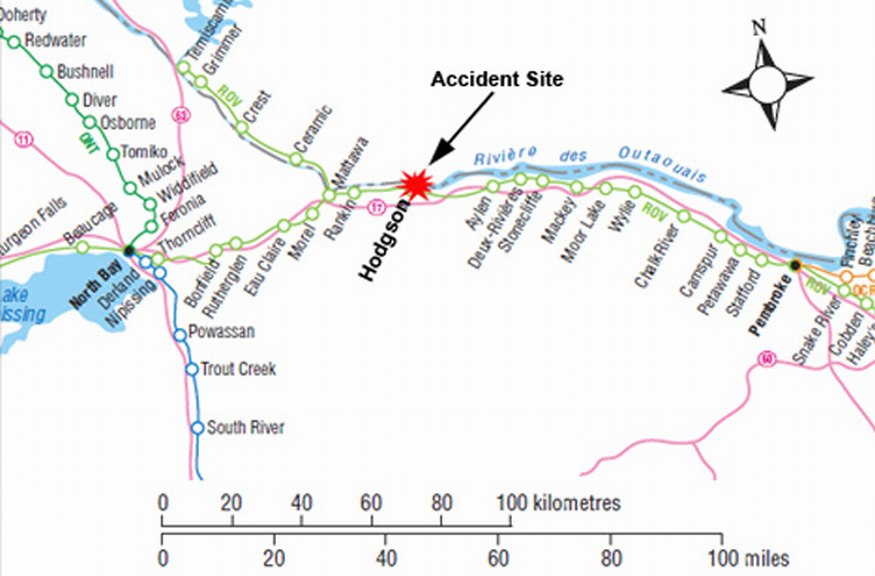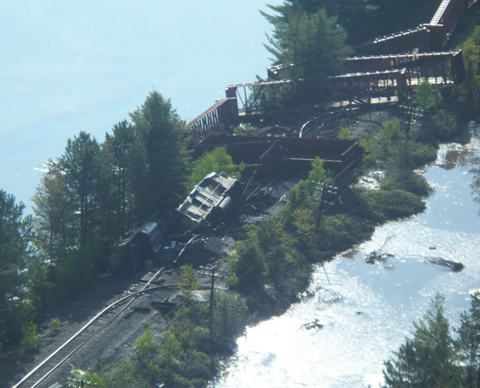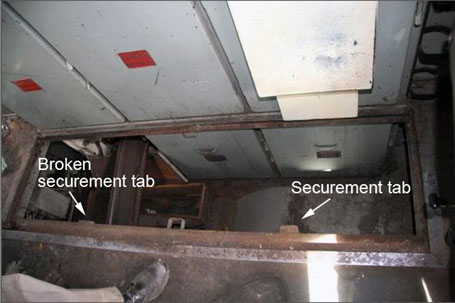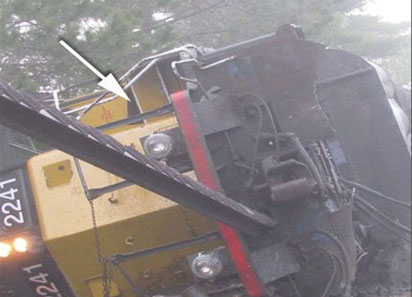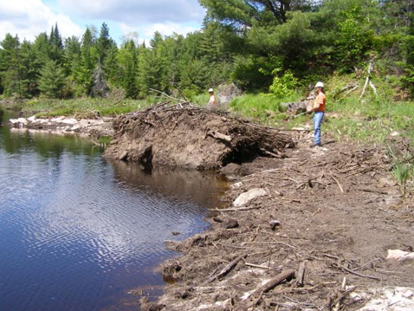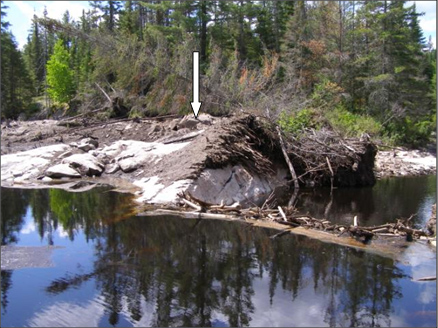Main-track derailment
Ottawa Valley Railway
Freight train, Cobden Turn
Mile 60.1, North Bay Subdivision
Hodgson, Ontario
The Transportation Safety Board of Canada (TSB) investigated this occurrence for the purpose of advancing transportation safety. It is not the function of the Board to assign fault or determine civil or criminal liability. This report is not created for use in the context of legal, disciplinary or other proceedings. See Ownership and use of content. Masculine pronouns and position titles may be used to signify all genders to comply with the Canadian Transportation Accident Investigation and Safety Board Act (S.C. 1989, c. 3).
Summary
On 03 June 2009, at approximately 0300 Eastern Daylight Time, the Ottawa Valley Railway freight train, the Cobden Turn, travelling westward, derailed two locomotives and seven cars at Mile 60.1 of the North Bay Subdivision near Hodgson, Ontario. The locomotives overturned, resulting in minor injuries to the crew. Approximately 17 000 litres of diesel fuel leaked from the locomotive fuel tanks, most of which flowed into the Ottawa River.
Ce rapport est également disponible en français.
Factual information
On 02 June 2009, at approximately 2200,Footnote 1 the Ottawa Valley Railway (OVR) freight train, the Cobden Turn (the train), departed Petawawa, Ontario, Mile 103.6 of the Chalk River Subdivision, destined for North Bay, Ontario, Mile 116.9 of the North Bay Subdivision. The train consisted of 2 locomotives and 29 empty cars. It weighed about 1130 tons and was approximately 2625 feet long. The crew members, a locomotive engineer and a conductor, were qualified for their positions and met fitness and rest standards.
The trip from Petawawa to Hodgson, Ontario, Mile 56.0 of the North Bay Subdivision, occurred without incident. As the train approached Mile 60.1, the crew members observed that the subgrade ahead had subsided, and an emergency brake application was initiated. The train was travelling at 37 mph when it was placed into emergency. It continued into the disturbed section of track and derailed. The lead locomotive fell into a void in the track subgrade and overturned onto its right side. Both locomotives and the first seven cars derailed.
The crew attempted to exit the cab by breaking the windshield. After several unsuccessful attempts, the crew climbed out of the conductor's side window, which was positioned overhead at that time. It took about 10 minutes longer than normally expected for the crew to exit the locomotive because of the difficulties encountered.
The locomotive engineer and conductor sustained secondary impact injuries. The locomotive engineer had been thrown forward and downward into an area between his seat and the cab heater. The conductor received a long contusion with a minor laceration on the side of his head because he had been struck by an unsecured floor panel during the derailment. Both crew members were taken to hospital, treated and released.
Environment Canada records indicate that, at the time of the occurrence, the winds were calm, fog was present and the temperature was 7°C. The previous week had seen record amounts of rainfall in the area. Between 26 May 2009 and 02 June 2009 (that is, 8 days), there had been 88 mm of rainfall in the Hodgson area, compared to the average monthly precipitation (May) of 50 mm.
Accident response
The train crew contacted the railway by cell phone to report the derailment. The site was not accessible by road. Access was gained by travelling in a hi-rail truck from the nearest roadway access approximately one mile west of the accident site. The access road was a single lane dirt road in poor condition across steep terrain. Cell phone coverage at the site was sporadic. Because the railway was single track, any movements with hi-rail vehicles had to be coordinated so as not to have two parties attempting to travel in opposite directions. The crew was taken by hi-rail truck by the first available engineering employee, to Mattawa, Ontario, Mile 72, and then to the Mattawa medical facility at approximately 0445. At approximately 0530, with the flood waters lowered enough and with daylight approaching, a visual inspection of the locomotives determined that the fuel tanks were dented. Further examination of the fuel tanks by mechanical staff at approximately 0800 revealed that the tanks had ruptured and the tanks had lost most of their contents. The loss of fuel was reported to CANUTEC at 0830 and then subsequently to the Ontario Ministry of Environment and Environment Canada. The remedial measures response was initiated at 0910. A helicopter survey was coordinated to ascertain the extent of the environmental cleanup required.
Site inspection
The track was damaged for approximately 460 feet. There were five locations where the track subgrade had washed away, ranging in length from about 6 feet to about 20 feet long. The two locomotives had dropped into two of these washed-out sections of track and sustained extensive damage. The seven derailed cars were jackknifed across the track with four cars positioned on the river bank and partially overhanging the Ottawa River.
Inspection of the locomotive cab revealed that one of the floor panels had been dislodged and had broken free from the floor. The anchor for the securement mechanism of this panel had broken away (see Photo 2). The fracture face of the broken anchor had an accumulation of dirt from exposure to the interior subfloor and did not have the luster of a fresh break.
Inspection of the locomotive cab exit points revealed that the battery box lid had fallen open and was preventing the nose door from opening (see Photo 3). The rear exit door was buried in the mud. The cab was not equipped with an emergency exit hatch, nor emergency exit windshields.
A nearby creek drained through a culvert in the track subgrade. The culvert was clear of debris and the water flow was unimpeded. A pond had formed bordering on the upstream side of the track subgrade. Water marks were discovered on the ballast, ties and rails approximately 10 feet above the water level that was observed after the accident. It was determined that the high water was due to the catastrophic failure of three beaver dams, up to 1.6 km upstream of the track; these dams were not visible from the OVR right-of-way. A large section of a beaver dam, measuring approximately 15 feet long, had been displaced from its location on a smooth bald rock (see Photo 4).
There were no signs that the beaver dam had failed by anything other than natural forces. Water markings showed that the water level in the beaver dam ponds had dropped by several feet, indicating that a large volume of water had been released recently (see Photo 5). The water course from the furthest beaver pond to the derailment site dropped in elevation by about 100 feet.
The Railway Track Safety Rules require that the roadbed “be maintained and kept free of obstructions, to accommodate expected water flow for the area concerned.” When the expected water flow has been or may be affected by the activities of beavers, the railway is responsible to control water levels that may affect safe railway operation. Additionally, section 25 of the Railway Safety Act and section 95 of the Canada Transportation Act facilitate access by the railways to adjacent lands as required to aid in identifying and mitigating the risks posed to their drainage system and to the integrity of the roadbed (see Appendix B).
Track and signal information
On the North Bay Subdivision, train movements are governed by the Occupancy Control System of the Canadian Rail Operating Rules (CROR) and are supervised by a rail traffic controller (RTC) located in North Bay. The North Bay Subdivision has an Automatic Block Signal (ABS) system. The previous ABS signal, signal No. 595, at Mile 59.5, displayed a clear signal indication.
The North Bay Subdivision is Class 4 track. The authorized maximum speed is 50 mph for freight trains. In the vicinity of the derailment, the track consisted of 115-pound continuous welded rail (CWR). The rail was laid on hardwood ties with double-shouldered tie plates and was box-anchored every second tie. The ballast was crushed rock. The cribs were full and the ballast extended beyond the tie ends to form full shoulders.
Track inspection
There were no known track defects in the vicinity of the accident. The track had been visually inspected approximately 17 hours before the accident. The track inspector had stopped and inspected the culvert at this location, with no deficiencies noted. During the inspection, the water level of the small creek that flows through the culvert was observed to be normal. There had been no history of drainage problems at this location.
Locomotive fuel tanks
Locomotives LLPX 2241 and LLPX 2221 were manufactured in 1976 and 1971, that is, before implementation of Association of American Railroads (AAR) Recommended Practice RP506 (effective 1995), which required a standard thickness of bottom and end plates. This recommended practice was superseded by AAR Standard S-5506 (effective 2001), which prescribes improved crashworthiness and spill limiting for new fuel tanks. The fuel tanks on the occurrence locomotives had neither the thicker end and bottom plates nor fuel spill-limiting features. These modifications are not a requirement for older locomotives.
Locomotive inspection
The occurrence locomotives were inspected regularly. During the previous 90-day inspection program, which was conducted on 06 March 2009, no deficiencies with the various panels and lids, as well as their securement hardware, were identified.
RailAmerica's locomotive inspection requirements state the following:
CARBODY
- Inspect all hinges, springs, latches, and slide bolts. Lubricate as necessary. Repair defects.
Inspection requirements at beaver dams
OVR began operations as part of RaiLink in 1996, and in July 1999, control of OVR was assumed by RailAmerica. RailAmerica's track inspection procedures for track side drainage and beaver dams specify the following:
Beaver Dams: Any change or blockage of a watercourse, or sudden change in depth of water, must be reported to the track supervisor immediately.
4. (e) In areas where beaver activity is common, a buildup of drift material is more likely and more frequent inspections are required, not only on the railroad right of way, but also upstream from the track where a sudden release of water from a beaver dam could cause a washout of the track.
OVR has no record of beaver dam inspections having been carried out in the vicinity of the accident site.
Before 30 October 1996, the North Bay Subdivision was owned and maintained by Canadian Pacific Railway (CPR). When this subdivision was part of CPR, the inspection of track side drainage and beaver dams was prescribed by CPR's Standard Practice Circular 32, which states:
9.0 Beaver Dams
- Beaver dams located upstream from the track, in streams that flow under or near the track, represent a potential hazard. Track Maintenance Supervisors must arrange regular inspections of beaver dams on their territory and take the necessary protective action if conditions are hazardous. On certain territories, an aerial inspection of dams may also be required in the spring and fall of each year to support ground inspections.
- An up-to-date list of beaver dams will be maintained on each Track Maintenance Supervisor's territory. The list should show:
- the subdivision mileage
- the side of the track on which the dams are located
- the number of dams
- whether the dams are upstream or downstream
- the distance of each dam from the track
- remarks regarding the condition of the dams
- the date of the inspection
Records of beaver dam locations and inspections, which had been kept in accordance with CPR's Standard Practice Circular 32, had not been retained nor given to OVR after the change in ownership in 1996.
Other occurrences involving beaver dam failures
On 19 July 1992, a Canadian National (CN) westward freight train derailed four locomotives and eight freight cars near Nakina, Ontario. The subgrade underneath the track at the derailment site had collapsed into Green Lake before the arrival of the train. As the front of the train travelled onto the portion of the track suspended in mid air, it fell into the lake, submerging the four locomotives. Two of the three crew members were fatally injured and the third sustained serious injuries. The derailment was caused by a breach in a beaver dam, which resulted in a sudden lowering of the water level in the lake, destabilizing the track subgrade and resulting in its collapse. Contributing to the accident was the placement of the embankment across the end of the lake, on a base composed of a mixture of peat and silt (TSB investigation report R92T0183).
On 07 April 1997, at approximately 0200 Eastern Daylight Time, CPR northward freight train 935-06 encountered a roadbed slump near Pointe au Baril, Ontario, Mile 44.8 of the Parry Sound Subdivision, derailing 14 cars and the locomotive consist. Approximately 45 000 litres (10 000 gallons) of diesel fuel leaked from damaged locomotive fuel tanks; the diesel fuel ignited and burned until it dissipated into the subgrade material. One crew member sustained serious injuries and the remaining two sustained minor injuries. The embankment collapse was attributed to a build-up of pore pressure in loose sand fill. The pore pressure was the result of the head of water created by a beaver pond along the west slope of the embankment. Contributing to the head of water was the rapid melting of snow during the two weeks preceding the derailment (TSB investigation report R97T0097).
On 18 July 1997, CN's main track at Mile 195.75 of the Bala Subdivision washed out as a result of a ruptured beaver dam. The washout was approximately 150 feet long and 50 feet deep. There were no trains involved (TSB investigation report R97T0200).
Locomotive crew egress
The United States Department of Transportation Federal Railroad Administration (FRA) conducted researchFootnote 2 to develop and evaluate innovative concepts for locomotive crew egress in the event of an accident that renders the normal means of egress unusable. This program focused on the following three egress concepts:
- roof-mounted hatch system with hand/footholds to aid climbing inside a toppled locomotive;
- easily removable door hinges; and
- internally removable windshields.
The FRA research showed that egress from the overturned locomotive mockup cab could be completed in less than 20 seconds by an uninjured crew member. The research showed that, in ideal circumstances, an injured crew member could be rescued from the locomotive mockup cab by trained first responders within 10 minutes.
Section 3, Emergency Egress, of AAR Standard S-580 (revised 2008) prescribes emergency egress as follows:
The locomotive cab must allow for exit through at least one opening (e.g., engineer's side door, nose door, windows) in any locomotive orientation.
See Appendix A for information regarding other occurrences in which egress from locomotives was problematic.
Environmental cleanup
Approximately 17 000 litres of diesel fuel and an undetermined amount of lubricating oil was released from the locomotives, most of which flowed into the Ottawa River. On 04 June 2009, OVR, the Ontario Ministry of the Environment (MOE) and Environment Canada conducted an aerial surveillance of the accident location. A petroleum sheen was observed floating on the Ottawa River, at locations up to 50 km downstream, near the community of Deux-Rivières, Ontario. The MOE reported that there was no observed impact to fish or other wildlife. Following the aerial observations and MOE's assessment, the extent of impact to the Ottawa River was recognized.
The environmental cleanup and remediation was extensive, using containment boom, absorbent pads and an absorbent boom to contain and collect the diesel fuel in the river. Approximately 915 m of containment boom, 940 m of absorbent boom, 650 m2 of absorbent pads, and 1 m3 of treated organic absorbent were deployed and used as containment and collection material. A total of 8 m3 of absorbent material was collected from the river and removed for off-site disposal. In addition, approximately 400 tons of fuel-contaminated soil was removed from the roadbed and riverside near the derailment.
Analysis
A review of the data from the locomotive event recorder (LER) and an inspection of the rolling stock revealed that neither the method of train operation nor the condition of the rolling stock were contributing factors to this derailment. The analysis will focus on the railway's practices regarding the management of heavy water run-off and its effect on local geographical conditions that are likely to have an impact on its operation, such as beaver dams. The analysis will also cover egress from the locomotive cab, securement mechanisms for access lids and panels on the locomotive, and crashworthiness of the locomotive fuel tanks.
The accident
The train derailed as it passed over sections of unsupported track. The record amount of rainfall (that is, 88 mm) in the previous week had resulted in increased ground water flow and accumulation. The resulting hydrostatic pressure from the rising water level in the beaver ponds led to a displacement of a 15-foot section of one of the upstream beaver dams. This beaver dam failure released a large volume of water, which had a cascading effect because two additional dams failed as the water flowed downstream. A pond formed against the upstream bank of the track subgrade when the accumulated water exceeded the capacity of the culvert. The water level rose rapidly and flooded the track, washing out several sections of the track subgrade, leaving the track intact but unsupported. As the washout was not visible until the train was only a short distance away, the train could not be stopped or significantly slowed before reaching the washed-out track sections.
Track washouts due to beaver dam failures
A sudden release of a large quantity of water can quickly damage a track bed, resulting in a track washout. In this occurrence, a beaver dam located approximately 1.6 km upstream failed, leading to the accident. OVR's track inspection procedures identify the potential consequences of a beaver dam failure and the need for more frequent inspections. In comparison, CPR's Standard Practice Circular provides guidance on the type of inspection, the need to maintain records of beaver dam locations and the need to be aware of certain times during the year when there is an elevated risk of beaver dam failures. The requirements prescribed in CPR's policy are much more comprehensive and will help identify high-risk locations where water has accumulated upstream from the track. Without a comprehensive strategy to identify high-risk locations for large water volume run-off events such as beaver dam failures, there is an increased risk of track washouts that can lead to derailments, injuries and damage to the environment.
Inspection of locomotive panel securement mechanisms
A broken anchor for a floor panel latch had not been identified for repair during the previous periodic maintenance inspection, allowing the floor panel to dislodge inside the locomotive cab. When locomotive panel securement mechanisms are not thoroughly inspected and maintained, there is an increased risk that unsecured panels can cause injury or block egress in the event of a locomotive rollover.
Locomotive crew egress during emergencies
The locomotive was derailed on its side and the normal points of egress (that is, locomotive doors) were blocked. Consequently, the only available egress from the locomotive cab was one of the windows above the crew members' heads, requiring them to climb upwards to exit. This delayed their egress by up to 10 minutes following the derailment. Although there were no adverse consequences from this delay, egress would have been difficult in situations involving injured crew members or in the presence of immediate hazards (for example, fire or chemical spills). Despite the occurrence locomotives meeting current egress requirements for locomotive cabs, as prescribed in AAR Standard S-580, the orientation of the derailed locomotive and the blocked doors resulted in significant delays for the crew members to exit the cab.
Environmental cleanup after the accident
The risk of damage and threat to the environment was not immediately apparent due to the priority given to evacuation of injured crew members, the remoteness of the location, and the darkness at the time of the occurence. Following aerial surveys of the diesel fuel and lube oil spill, the MOE and Environment Canada coordinated an extensive cleanup with OVR to mitigate damage to the environment.
Locomotive fuel tanks
Because the lead and trailing locomotives were 34 and 39 years old respectively, neither fuel tank had been constructed to meet the requirements of current AAR Standard S-5506. Fuel tanks built to this standard have better strength and puncture-resistance properties. When fuel tanks constructed to the current standard are breached, the loss of fuel oil and the risk of adverse environmental consequence can be minimized.
Findings
Findings as to causes and contributing factors
- The train derailed when it passed over sections of washed-out track roadbed.
- Heavy rainfall in the week before the accident had resulted in increased ground water flow and accumulation.
- Hydrostatic pressure from the rising water level in beaver ponds led to the displacement of a large section of one of the beaver dams. This released a large volume of water, resulting in a cascading effect as two other downstream beaver dams gave way.
- A pond formed against the upstream bank of the track bed when the accumulated water exceeded the capacity of the culvert. Consequently, the water level rose rapidly and flooded the track, washing out several sections of the track subgrade but leaving the track intact and unsupported.
Finding as to risk
- Without a comprehensive strategy to identify high-risk locations for large water volume run-off events such as beaver dam failures, there is an increased risk of track washouts that can lead to derailments, injuries and damage to the environment.
- When locomotive panel securement mechanisms are not thoroughly inspected and maintained, there is an increased risk that unsecured panels can cause injury or block egress in the event of a locomotive rollover.
- When fuel tanks constructed to the current standard are breached, the loss of fuel oil and the risk of adverse environmental consequence can be minimized.
Other findings
- Despite the occurrence locomotives meeting current egress requirements for locomotive cabs as prescribed in Association of American Railroads (AAR) Standard S-580, the orientation of the derailed locomotive and the blocked doors resulted in significant delays for the crew members to exit the cab.
- Following aerial surveys of the diesel fuel and lube oil spill, the Ministry of the Environment and Environment Canada coordinated an extensive cleanup with the Ottawa Valley Railway (OVR) to mitigate further damage to the environment.
Safety action taken
The TSB issued Rail Safety Information Letter (RSI) 03-09 concerning broken securement mechanisms on locomotives. In response, Transport Canada completed a survey of federally regulated railways having locomotives with removable floor panels and is satisfied with its instructions for inspecting securement mechanisms. During inspection activities, Rail Safety inspectors will review the condition of floor panels and verify that railway inspections are being performed as required. In addition, the Ottawa Valley Railway (OVR) holds regular meetings to remind employees of the importance of a thorough and exacting inspection and to report equipment defects or issues as they become known.
The TSB issued Rail Safety Advisory (RSA) 06-09 concerning the adequacy of beaver dam inspection practices on RailAmerica. In response, RailAmerica revised its 2010 Safety Management System Safety Action Plan to include a commitment to conduct aerial inspections to assess beaver dams off the OVR right-of-way once a year, aimed at identifying high-risk areas beyond the range of conventional right-of-way and culvert inspections. Once the areas are identified, OVR will coordinate with the Ontario Ministry of Natural Resources to cause breakage of, or release from, the dams consistent with the relevant conservation legislation and protection of property.
This report concludes the Transportation Safety Board's investigation into this occurrence. Consequently, the Board authorized the release of this report on .
Appendices
Appendix A – Other occurrences involving egress from an overturned locomotive
On 02 May 2002, a freight train derailed 2 locomotives and 21 freight cars after colliding with a loaded tractor-trailer, near Firdale, Manitoba. The derailed equipment included five tank cars carrying dangerous goods, four of which sustained multiple punctures and ignited, resulting in a large fire. Egress from the front of cab, furthest away from the fire, was not possible due to the damaged safety appliances blocking the doorways. The crew exited from the rear cab door, which was closer to the fire (TSB investigation report R02W0063).
On 10 October 2003, a freight train derailed 2 locomotives, both on their side, and 20 cars after it struck a loaded truck near Saint-Pascal, Quebec. One tank car loaded with chlorine, UN 1017, was on its side but not leaking. The locomotive engineer sustained serious injuries and was transported by ambulance after egress was accomplished by kicking out a cab window (TSB occurrence R03Q0049).
On 22 August 2005, a VIA Rail Canada Inc. train collided with a loaded tractor-trailer at a crossing near Monet, Quebec. The locomotive and three of the four cars derailed and approximately 1900 litres of diesel fuel was spilled. Two of three employees on the locomotive were injured and had difficulty gaining egress from the cab (TSB investigation report R05Q0040).
On 03 September 2006, a White Pass and Yukon train derailed the locomotive and six cars near Log Cabin, British Columbia, resulting in the fatal injury of one person and serious injury of three others. The locomotive came to rest on its side. Rescue of the survivors was hampered as egress from the cab was obstructed (TSB investigation report R06V0183).
On 03 January 2007, a freight train struck a snow slide and derailed three locomotives near Prince George, British Columbia. Egress from the upright locomotive was obstructed by snow that had completely blocked the cab doors and windows. The crew remained in the cab until emergency responders dug them out (TSB occurrence R07V0007).
On 04 January 2007, a freight train struck a landslide near Lasha, British Columbia, derailing two locomotives and one car. The lead locomotive slid on its side down an embankment to the edge of the river. The injured crew awaited rescue from emergency responders. Egress from the locomotive was gained through one of the side windows by the crew (TSB occurrence R07V0005).
Appendix B – Pertinent Railway Safety Act and Canada Transportation Act excerpts
Railway Safety Act
Power of railway companies on adjoining lands
25. (1) For the purpose of preventing a threat to safe railway operations on a line of railway operated by a railway company, or for the purpose of restoring safe railway operations on a line of railway operated by a railway company,
- the company may
- at any time, enter onto any land adjoining the land on which the line of railway is situated for the purpose of maintaining or altering railway works or removing obstructions to them if no other access to the line of railway is reasonably available, and
- remain on the land for as long as is necessary to accomplish that purpose;
- the company may, at any time, enter onto any land adjoining the land on which the line of railway is situated for the purpose of dealing with any fire occurring on either of those lands;
- the company may, at any reasonable time, on giving notice in writing of its intention to do so to the owner of any land adjoining the land on which the line of railway is situated, enter onto that adjoining land to cut down trees or brush that has been permitted to grow on that land in contravention of regulations made under paragraph 24(1)(e); or
- the company may, at any time between November 1 and March 31, enter onto any land adjoining the land on which the line of railway is situated to install or maintain a snow fence.
Canada Transportation Act
General powers of railway companies
95. (1) Subject to the provisions of this Part and any other Act of Parliament, a railway company may exercise the following powers for the purpose of constructing or operating its railway:
- make or construct tunnels, embankments, aqueducts, bridges, roads, conduits, drains, piers, arches, cuttings and fences across or along a railway, watercourse, canal or road that adjoins or intersects the railway;
- divert or alter the course of a watercourse or road, or raise or lower it, in order to carry it more conveniently across or along the railway;
- make drains or conduits into, through or under land adjoining the railway for the purpose of conveying water from or to the railway;
- divert or alter the position of a water pipe, gas pipe, sewer or drain, or telegraph, telephone or electric line, wire or pole across or along the railway; and
- do anything else necessary for the construction or operation of the railway.
